Official
photos of Sony Ericsson S700
Sony
Ericsson S700, live pictures
Standard kit:
- Phone
- Battery
- Charger
- Stereo headset
- Memory Stick 32Mb card
- Manual
In case of S700Sony Ericsson has changed its rule of unveiling a
new model shortly before releasing it on the market. Planned to be
selling in Q4 of 2004, the phone had been showed in spring, more
than half a year earlier. Such “strange” action has its reasons,
which are: 1) the S700 has its prototype on the Japanese market (the
SO505i); 2) the company wants to show a gadget of such class as
earlier as possible because of upcoming rival announces on the
background. Can't say if such a rush has sense, after all when it
was demonstrated to journalists it was a Japanese prototype, there
was no working S700s around. The phone should had a firmware which
the showed along with it K700
had. As a note, the K700 was quite unstable to that moment; its
hardware and software were not of the best quality. It was pretty
clear that the company rushes to be the first one to unveil a
megapixel mobile gadget. As for now, the S700 is a totally working
device and “running its final lap” to the market. Let's see what
features it offers.
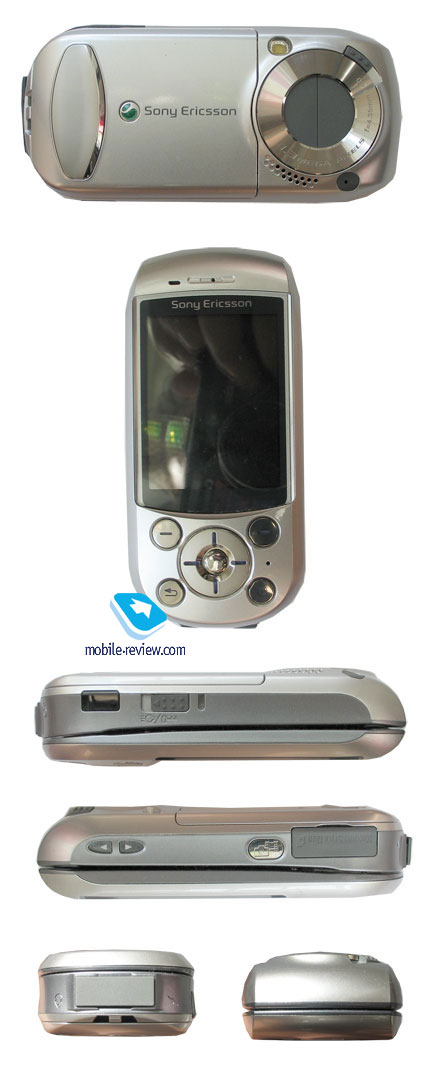
The phone has an uncommon design - developers have tried to
combine a mobile phone and a camera. If you take a look on phone's
front you won't see any surprises – just a screen and few soft keys.
Now, if you turn the phone around and look on its back you'll notice
that it looks just like a regular digital camera. Don't know what
the S700 has more of, a phone or a digital camera, during the usage
of the phone this question came up quiete often. I won't consider a
camera here, you can read about its abilities in
a separate review.
S700's opening mechanism is similar to the one that Motorola's
v70 and v80
have. Two halves are rotating one over another, denuding a keyboard.
unlike Motorola v80, the phone has no auto-open mechanism, so, one
should open it manually with an effort. The hard part here is that
the mechanism is quite taut and can't be opened using one hand. This
is caused by phone's dimensions, to open it with one hand one should
have a big enough palm. Another hard part is a logical one. The
opening performs from up to down (i.e. a joint is placed in a lower
point, where a navigational key is), the device can be opened either
to the left or to the right – there is no difference except for a
closing which must be performed in the same direction (there is no
360 degree rotation). So, here the hard part comes up: after you
open the phone it gets turned 180 degrees, i.e. the screen and the
keypad will be in the wrong positions and you must turn the phone
again which causes an inconvenience as an explanation of this
inconvinence. Should we consider its camera part? Indeed, it's
easier to open the phone from horizontal position and it lies in a
hand as it supposed to. Originality of this type of construction
isn't so interesting because one needs to get used to using it. A
slider type opening mechanism would be more preferable here and
would look more logical.
Dimensions of the phone are pretty big comparable to those of
similar devices (107.5 x 49 x 24.5 ìì ), weight is 137 g.
While the phone is closed one can receive calls, redial, browse
the menu etc. The need for opening the phone appears when dialing a
new number, performing text input, using one or another function.
Practically, if you make phone calls mostly to numbers from your
phonebook or do not use message services you won't open the phone
too often.

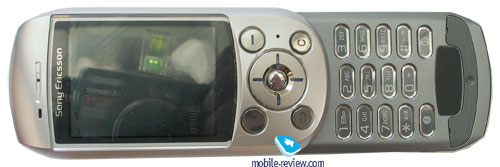

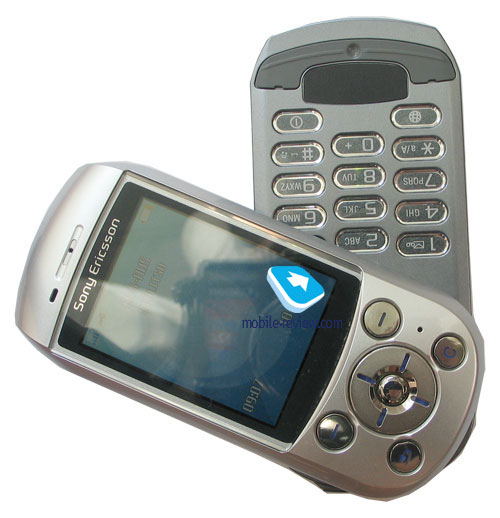
S700's display has 240x320 (2.3 inches) resolution and supports
up to 262K colors. Up to 8 text lines and 3 service rows (including
a header) can fit on the screen. The amount of information displayed
on the phone's screen is exactly the same as one on the K700's but
the fonts look bigger. An explanation to this is that the S700 has
the same firmware as the K700 but with minor changes. For instance,
graphic files (icons) are displayed in three rows in most menus, not
two. For the rest, all the interface elements are the same but
enlarged to fit display of bigger sizes.
The display's quality is one of the best in its class. It is not
as bright and vivid as Samsung
D410's one but has something in common with a display of Sharp's
GX30. It can be compared to displays by Motorola, Samsung, but
not another vendors', they are worse.


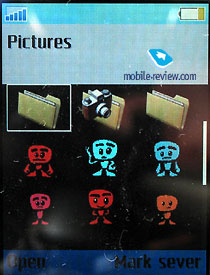

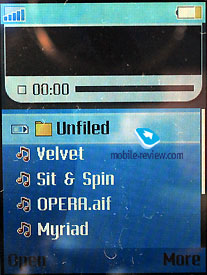
The screen fades on the sunlight but remains visible, partly
because of the display's dimensions.
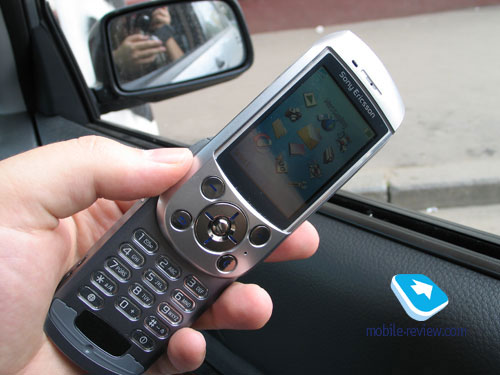
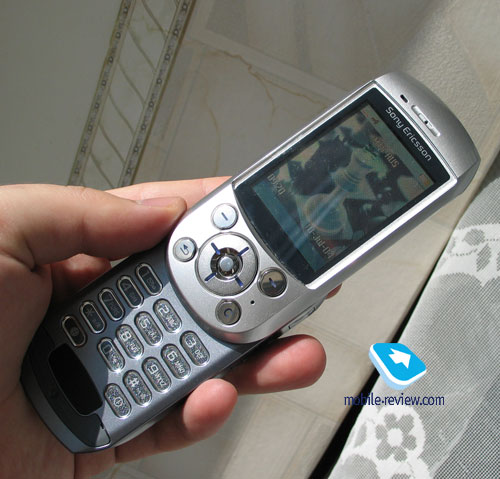
Having opened the phone you gain access to its keypad. Keys are
big and placed well. It is very comfortable to use them – mostly due
to the device's dimensions. Keypad has blue backlight, all
inscriptions on keys are visible.
A switcher which enables keypad locking (when the phone is
closed) is placed on the left side. It also activates backlight in
camera mode. IR-port is placed next.
On the opposite side you can see volume control keys, they are
located at the bottom and that isn't always comfortable when the
phone is opened. Also there is a camera key and MS Duo slot there.
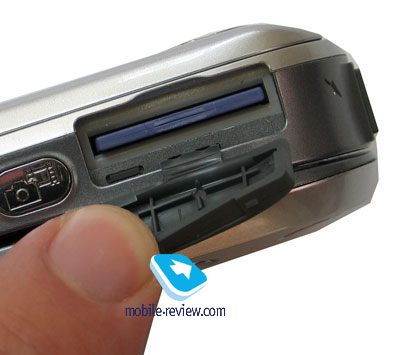
Interface connector is on the upper side. It is protected by a
rubber stub which, in turn, is attached to the phone. The connector
is similar to the ones on the earlier models.

And few words about the battery. It's Li-Ion and has a capacity
of 780 mAh. The battery is located behind a back lid which can be
removed by pressing on the fastening points, not by pulling it.
Manufacturer states that the phone's standby time is up to 300 hrs
and talk time is up to 5.5 hrs. Average work time for S700 when
using (45 min of talk time + 30 min of using different functions) in
MTS-Moscow operator's zone is 2 days.

MENU
Functionally this phone is a copy of Sony Ericsson K700, that's
there will be a quoting from the respective review. The only
difference here is the presence of the Memory Stick Duo slot for
cards which can hold photos taken from built-in camera, mp3 music
(the phone can be used as an mp3-player). In the second case, an
application for playing mp3-files remains the same, no changes to it
have been made. Also the screenshots of the phone's display haven't
been updated, keep in mind that the S700's display a little bit
larger than the one of the K700.
When you turn on the phone a setup wizard appears and greets you,
it is there to help you to set up your S700. Few pictures describe
basic soft keys, further the wizard offers to input current date,
time, to copy phonebook entries from a SIM-card to the phone's
memory. In the very beginning you choose a menu language. This
action is often a bit hard to take on another phones. Pretty simple
function, first embedded into K700. Potentially, the wizard can make
it easier for the first time Sony Ericsson phone user to get used to
it. Later you can turn off the wizard or leave its setting to start
it every time you turn the phone on.
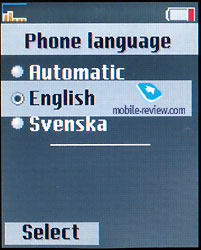

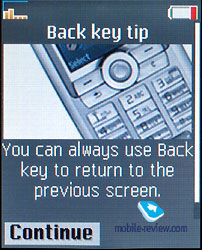


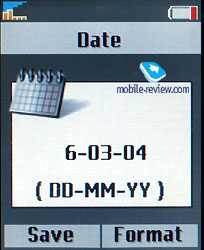
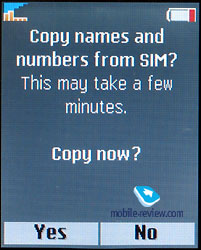
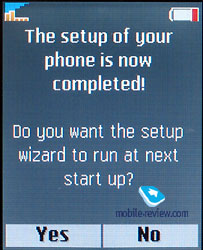
Now, the phone is on and there is familiar design on the screen.
Let's press a navigational key in one of the directions and see the
result. The phone signalizes that the action taken has no shortcut
assigned to it and offers to assign it. It takes just five minutes
to assign the most needed functions to all joystick directions.
Curiously enough that when setting up shortcuts the menu appears
with a shortcut picture underlay.

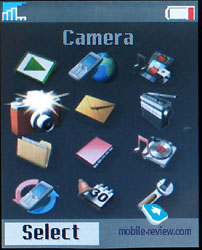

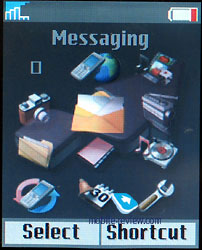
The main menu is presented by four rows with three icons in each
one. Unlike earlier versions of the phone the icons look much
pretty, they're drawn better. It is caused by higher screen
resolution and better picture displaying. There is an animation
embedded into the menu: while browsing through the menu items a
circle flows from one to another, backlighting the selected icon.
The animation is extremely pleasant and doesn't pall even if using
the phone for a long time. The menu speed with the animation turned
on is a subject for the praise – there are no slowdowns, everything
is surprisingly fast. One can do fast navigation using shorcut
number navigation. Getting desired menu sub-item would take a moment
in that case.
Text input remains on its comfort level, so, pressing the “#” key
brings out a list of the available languages and you can easily
switch between them while typing.
And that is not all concerning the interface changes. Besides
traditional vertical sub-menus, the vendor has provided thematic
horizontal tabs. It means that while viewing a list of the dialed
numbers, one can see not only the dialed numbers but in the same
time (horizontal joystick striking) switch between missed and
received call tabs. In the phone menu this kind of navigation is
provided anywhere it's possible and it makes using the phone much
easier. The menu ergonomics is quite high in this phone model. I
also note that such horizontal panels appear in Phonebook, Settings
and another menu items as well.

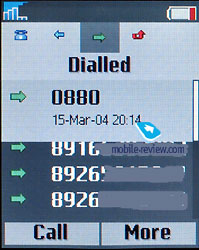
CAMERA. For the first time Sony Ericsson's GSM
phone has a built-in 1.3 megapixel camera. You can read a separate
review about it.
Radio. The phone has a built-in FM radio which
can store up to 20 channels in its memory. A stereo headset included
into the supply kit, functions as an antenna. In Moscow , using an
autosearch feature the phone sets up 6 or 7 radio stations with the
strongest signal coverage. In the same time, stations with a weaker
but good signal are missed and can be added into the stations list
manually. This feature is identical to Nokia's phones, which have
the same problem.
.jpeg)
.jpeg)
.jpeg)
.jpeg)
A signal reproduction quality is high, the headset allows to set
almost any volume level you want. Maximum level is excessive – music
silences everything. The radio can either be played through a
loudspeaker, in that case it can be heard by people around, speaker
volume is pretty high.
Unfortunately, the radio can be controlled with the keypad only.
For instance, switching between channels saved to the memory is
performing by striking the joystick vertically. The volume level can
be adjusted by pressing side keys. If you want to switch to another
menu item you can minimize the radio just like you do it with an
application on your PC's desktop. To gain a control over the
minimized radio again, you just have to choose the Radio
application. While the radio is minimized, a corresponding icon
appears on the screen.
Shortly, the impressions regarding the radio can be described as
positive, the phone is really interesting by this parameter,
moreover it offers the qualitative implementation of this function.
The radio isn't worse than one in Nokia phones, besides it works in
stereo mode.
File manager, available memory. S700 has 32Mb of
internal memory, 30Mb are available to a user who can store there
different data, files (photos, videos, applications). The rest part
of the memory is occupied with preinstalled applications which
usually cannot be deleted. Another part of the memory is reserved
for such functions as the phonebook, lists of calls etc. Plus you
can always use a memory card. One (32Mb) is included into the supply
kit.
.jpeg)
The phone introduces a simple file manager, it can sort files in
folders, create new folders and store the files in them. We didn't
manage to use the internal memory as file keeper – the phone has
refused to accept files with unrecognized extensions. But once an
extension had been changed it could has been transferred to the
phone freely. An attempt to view such file have caused an error but
the phone haven't stuck and continued to work normally. Further,
from the file manager such file could have been sent through IR-port
or via Bluetooth. So, using that little trick with an extension, the
phone can be used as a keeper and transporter for small or/and
important files.
File manager makes it easier to work with files, it helps to
regularize tons of photos, prepare them for transferring to a PC.
The S700 has the T610/T630 problem – the size of a picture in the
phone's memory is twice bigger than in PC's memory. Possibly it is
caused by particularities of the file system. Curiously enough that
the properties for a picture show correct file size but free memory
reduces greater. Considering the huge memory available, this problem
shouldn't be paid much attention.
Player. The S700 has a built-in mp3 and 3GP
player. It has come from Sony Ericsson Z1010 and is a perfect tool
to listen to mp3 files.

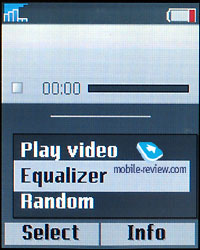



The player has an equalizer which, in turn, has few presets
(Bass, Voice, Tremble etc.) and a possibility to create your own
settings. The equalizer changes sound noticeably.
Phonebook. Phonebook's possibilities are the
same as T610's one have, but its interface has been changed
significantly. For instance, one name can be associated with few
phone numbers, e-mail address, other contact info. In the phonebook
settings you can choose necessary fields which should be displayed
while filling contacts. There is a possibility to sort by fields (by
name or surname), but there is only one entry. Such sorting is
important only while transferring data from PC, for phone’s entries
it’s actually useless. Each name can be assigned to its own ringtone
and picture. In that case incoming call causes playback of the
selected ringtone and displaying the selected picture.
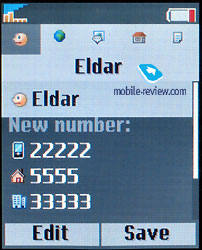

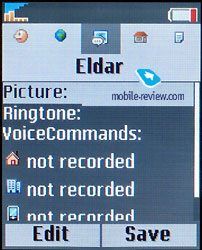
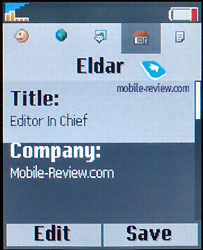
While filling contacts you can switch between bookmarks. The
first bookmark is used for phone numbers input and sorting them by
types. The bookmarks have something in common with Outlook's ones
and it is comfortable. Up to 40 voice notes can be made for phone
numbers assigned to a name. You remember, earlier voice marks were
assigned only with a name, additional numbers (home, office etc.)
were required additional voice marks.


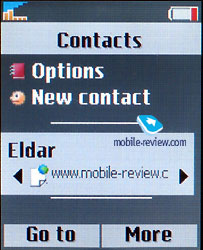
While viewing a record in the phonebook, phone numbers and other
information can be scrolled with horizontal joystick striking.
Naturally, the default number choosing is up to a user.
Company traditionally considers that a SIM-card is not suitable
for storing constant information. Data stored on SIM-card can be
viewed from a separate menu, they are not displayed in the general
list.
Messages. All functions are basic for messages,
there are few default templates, others can be created. Messages are
stored in the phone's memory and on the SIM-card as well. Chat is
also available. Particularly want to say about emoticons – they are
made on the high quality level and emphasize youth phone component.


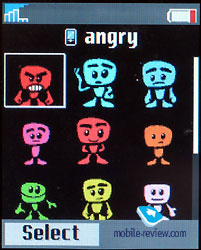
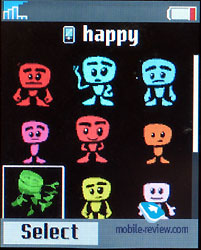
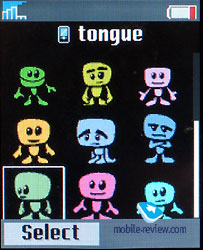
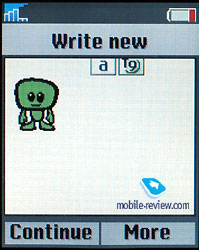
MMS realization is done great, you can really create your own
video clips. The number of settings and the simplicity of their
usage makes the great advantage for the S700 over another phones.
An e-mail client supports sending and receiving of the messages,
supports all kind of encodings including all Russians.
This menu item now holds a sub-menu called “Instant Messaging”, a
kind of analog of mobile ICQ. The technology is getting spread and
when the phone comes out on the market, Instant Messaging will be
used by some part of mobile phone users.
Call lists. General calls list displays up to 30
records with date and time of a call. There is an icon beside each
record showing a call type (missed, received, dialed). Besides that,
there are icons in the general calls list which show if a phone
number is in the phonebook or on the SIM-card. A list of missed
calls can also be viewed separately, it can hold up to 10 records.
Here you can view a cost or duration of the last call and of all
calls. Switching between different lists is possible by using
bookmarks, they save time greatly.


Entertaiment. This menu item provides access to
a photo album, list of music files. MusicDJ is an interesting
function although it isn't used by a wide range of consumers. It
provides you with an ability to make your own melodies editing up to
4 tracks.
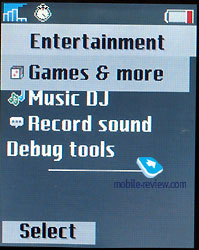


For the creative persons S700 has a graphic editor. Working in
it, one can create simple graphics. Sometimes it can help to kill
time but often this function is excessive.
Organaizer. There are a lot of functions beneath
an Organizer menu. First, let's take a look at a calendar. There are
three types of events viewing: week view, month view or today
events. In the last case you see a list of all appointments and
notes, another two modes display time and appointment or the day.
You can choose a date to go to. Everything here is rather
traditional. You are able to choose a type of an appointment by
selecting one of 6 icons, type a place of the appointment, its time,
add a reminder for it (beforehand or in the entered time). A way for
setting up repeated appointments hasn't been found, my S700 hasn't
had such function. Using an edit menu, time and date for a
particular appointment can be adjusted but that's it. Reminders work
even if the phone is switched off, if that option is marked in
settings. A pleasant feature of the phone is an automatically
switched profile when an appointment starts or ends. Partly, it is
an analogue of Nokia's Time Profile.
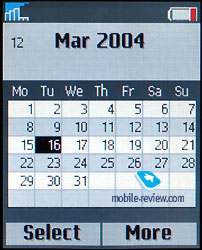

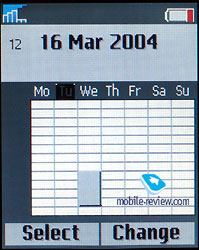
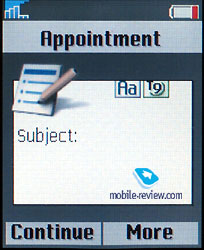
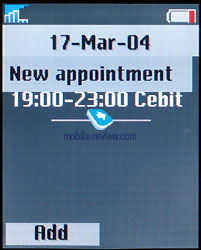
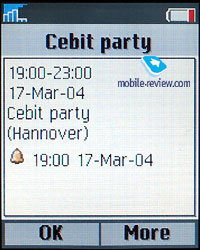
A task list is ascetic, there are only two types of tasks in it:
a call and a reminder. But on the other hand, this is enough, this
simplicity has its pros.
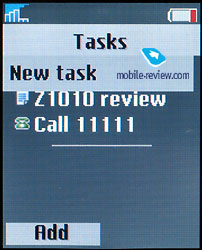

The phone has full-fledged calendar search – you input a search
criteria (a word or a part of it) and the phone displays all the
appointments matching this criteria. The search works fast even if
there are more than 100 appointments scheduled. You can also quickly
go to a particular appointment from a resulting search list.
Scheduled events can easily be sent to another devices (as
always, through IrDA or via Bluetooth). You just have to choose a
desired time interval – a day, a week, a month – and then send all
the records. But a receiving device should have a built-in PIM to
receive and display that data. You can send your info to a TV
through an IrDa but it is unable to display them. In that manner,
you can receive data, for instance, from home or office PC without
using any extra synchronization software.
Notes. The phone can store short text notes. Notes list displays
the first word form a note. It isn't always comfortable because one
should start a note with a keyword to know what is it about.
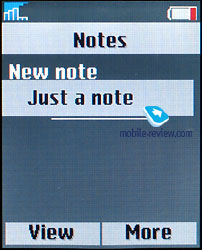
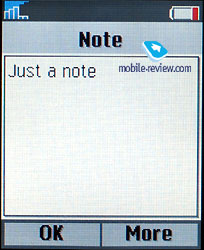
Alarm. An alarm can be set to regular or recurrent mode (the
alarm can ring on selected days of the week). Alarm works even if
the phone is switched off.
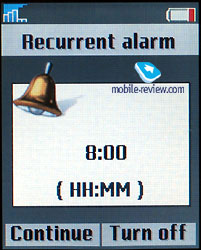

Countdown timer is rather standard either as a stopwatch. The
phone has a code reminder which is loved by lots of people. The
calculator became better, it is comfortable to work with it.
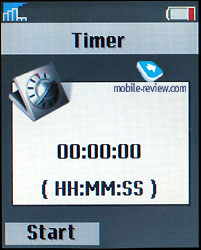
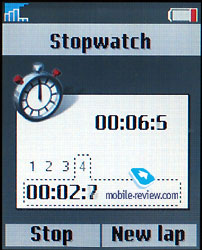
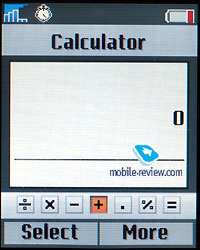
Connectivity. This menu item is responsible for
the phone communications - from WAP and GPRS to Bluetooth and
synchronization. I won't describe here the standard methods of using
them, they are pretty obvious, everything works fine. I want
particularly emphasize Bluetooth's stability, it doesn't cause any
problems to the phone at all, synchronization has no problems
either, all profiles are supported.
.jpeg)
Here you can also find setting for a remote and a local
synchronization, everything is also standard.
WAP. WAP-browser has a dedicated menu item. Its
version is 2.0 and it supports secured connection which is important
for an electronic transactions. Using the browser, new wallpapers,
themes, ringtones, which are available on vendor's site, can be
downloaded to the phone .
Settings. Properly speaking, this menu item
contains all options regarding phone's work and partly screen's
look. All the options are traditional and there is no need to
describe them. We just want to emphasize the presence of the renewed
themes, they can dramatically change the look of the screen.


Java. The S700 supports Java (MIDP 2.0) and also
has a 3D engine which allows to run real 3D games. Shortly note that
games became more interesting, they start comparatively fast. In our
opinion regular Java-games, which are also available for T610, run
faster on S700. I won't describe preinstalled software here because
it may vary depending on a country.
Impressions
Phone's connection quality doesn not deserve any censures, the
phone works well. A 40-tone polyphonic ring is loud enough, the
phone can be heard in different conditions. A vibrating alert's
strength is mid or a bit lower.
Impressions concerning the phone are extremely mixed. The camera
is not bad, on the one hand, it has a great display, polyphonic
ringtones, MS Duo slot. But on the other hand, the phone
construction isn't really thought-through and logic. The device has
more from a digital camera than from a mobile phone, which puts on
some restrictions. The phone's design is very original and won't
suit everyone, it has its own range of users. I recommend you to
play with the phone for 20-30 minutes before buying it, this would
help deciding whether it suits you or not.
In November, when the phone gets to the market, S700 will be the
one of few gadgets with such features. Although there is already
Sharp GX30 that doesn't own an innovative design but supports
similar features (totally, the GX30
is weaker but not significantly). Unfortunately, I can't share
everyone's delight concerning S700. It is designed for a particular
range of users, it has interesting features but it is not the
company's top model. Probably it will have good sales in its market
segment but no more than that. When the phone comes out its cost
will be about 550 USD. It must be clear that in a couple of months
there will be a classic designed version of the S700 which will have
another screen (smaller in dimensions and resolution) but with other
similar features. By its dimensions it will stand between the S700
and the K700. Unveiling of this model should be expected on
September, the 19-th 2004, but the company may change its rule and
unveil the new model earlier.
Links:
- Sony
Ericsson S700 – abilities of the mega-pixel camera



